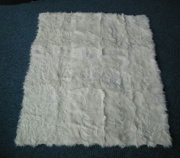Difference between revisions of "Lambskin"
Jump to navigation
Jump to search
(username removed) |
|||
| (3 intermediate revisions by 3 users not shown) | |||
| Line 2: | Line 2: | ||
== Description == | == Description == | ||
| − | The tanned skin from a young sheep. Lambskin is lighter in weight than sheepskin. Vegetable tanned lambskin was used as a bookbinding leather in the second half of the 19th century. It was valued for its softness and blemish-free surface. Lambskins obtained from Tuscany were highly valued. They were used to make [ | + | The tanned skin from a young sheep. Lambskin is lighter in weight than sheepskin. Vegetable tanned lambskin was used as a bookbinding leather in the second half of the 19th century. It was valued for its softness and blemish-free surface. Lambskins obtained from Tuscany were highly valued. They were used to make [[doeskin leather|doeskin]] and [[chamois leather|chamois]]. Lambskin, obtained shortly after shearing, is also prepared with the fleece intact and used for soft, warm clothing, and padding. |
== Synonyms and Related Terms == | == Synonyms and Related Terms == | ||
| − | + | piel de cordero (Esp.); cuir d'agneau (Fr.); agneau (Fr.); lamshuid (Ned); pele de cordeiro (Port.) | |
| − | == | + | == Resources and Citations == |
| − | * | + | * G.S.Brady, ''Materials Handbook'', McGraw-Hill Book Co., New York, 1971 Comment: p. 705 |
| − | * | + | * Matt Roberts, Don Etherington, ''Bookbinding and the Conservation of Books: a Dictionary of Descriptive Terminology'', U.S. Government Printing Office, Washington DC, 1982 |
| − | * | + | * Random House, ''Webster's Encyclopedic Unabridged Dictionary of the English Language'', Grammercy Book, New York, 1997 |
| − | * | + | * Edward Reich, Carlton J. Siegler, ''Consumer Goods: How to Know and Use Them'', American Book Company, New York City, 1937 |
| − | * | + | * American Leather Chemists Association Glossary at www.leatherchemists.org |
[[Category:Materials database]] | [[Category:Materials database]] | ||
Latest revision as of 09:02, 17 August 2020
Description
The tanned skin from a young sheep. Lambskin is lighter in weight than sheepskin. Vegetable tanned lambskin was used as a bookbinding leather in the second half of the 19th century. It was valued for its softness and blemish-free surface. Lambskins obtained from Tuscany were highly valued. They were used to make doeskin and chamois. Lambskin, obtained shortly after shearing, is also prepared with the fleece intact and used for soft, warm clothing, and padding.
Synonyms and Related Terms
piel de cordero (Esp.); cuir d'agneau (Fr.); agneau (Fr.); lamshuid (Ned); pele de cordeiro (Port.)
Resources and Citations
- G.S.Brady, Materials Handbook, McGraw-Hill Book Co., New York, 1971 Comment: p. 705
- Matt Roberts, Don Etherington, Bookbinding and the Conservation of Books: a Dictionary of Descriptive Terminology, U.S. Government Printing Office, Washington DC, 1982
- Random House, Webster's Encyclopedic Unabridged Dictionary of the English Language, Grammercy Book, New York, 1997
- Edward Reich, Carlton J. Siegler, Consumer Goods: How to Know and Use Them, American Book Company, New York City, 1937
- American Leather Chemists Association Glossary at www.leatherchemists.org
